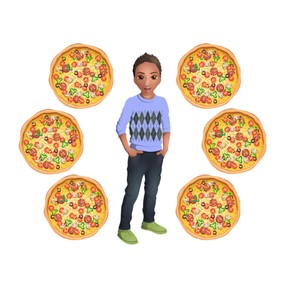
Literal and non-literal meanings of words and phrases in context
I can distinguish between the literal and non-literal meanings of words.



8,000 schools use Gynzy
92,000 teachers use Gynzy
1,600,000 students use Gynzy
General
Using literal language means to use the dictionary definition of a word, but this is not always how we speak. Sometimes, we use non-literal language, a type of "figurative language" that often exaggerates something to help us better describe something or have a reader understand what we're trying to say. In this lesson, students will learn to distinguish between literal and non-literal language.
Standards
CCSS.ELA-Literacy.L.3.5a
Learning objective
Students will be able to distinguish between the literal and non-literal meanings of words and phrases in context.
Introduction
Ask students to solve the word mystery in each sentence. Can students use the context clues to help figure out the meaning of the underlined word? Ask students which context clues they used to help determine the meaning of the underlined words.
Instruction
Explain the difference between literal and non-literal language. Literal language is the actual meaning of a word or phrase, based on the dictionary meaning of the word. Non-literal language is also called figurative language because it is often silly or unrealistic. It goes beyond the dictionary meaning of the words or phrase and often has a different meaning altogether. Give examples of literal and non-literal examples. Then ask students if they can determine if the given sentences are literal or non-literal. Then ask them to match sentences to the image that best represents it. Challenge students to determine if the sentence is literal or non-literal. Show students a selection of figurative language pictures and write what they mean. Then ask students to drag the phrases into the category literal or non-literal. Then ask students to find non-literal language in context by asking them to read a text and to underline the non-literal phrase. Then highlight the correct non-literal saying in each sentence. You can choose to hand out sheets of paper to students to draw the following non-literal images and do a picture walk in the classroom, or you can ask a student to come to the front to draw on the interactive whiteboard. Have students then determine if a given sentence is literal or non-literal and explain their thinking. How do they know/determine that it is literal or non-literal?
Quiz
Students are given a sentence and must decide if the underlined phrase is literal or non-literal. They must then select the correct definition for a selection of non-literal phrases.
Closing
Remind students that they have now learned how to distinguish between literal and non-literal meanings of words and phrases in context. They are able to determine what literal or non-literal language is, and know some examples. Close by having students work in pairs to choose a non-literal phrase and to come up with a sentence to use the phrase in context. Share with the class.
Related Lessons
To further help students recognize new vocabulary and rhetorical devices, you can check out these Gynzy lessons:
- Distinguish between literal and non-literal language
- Use context as a clue to the meaning of a word or phrase
- Determining meaning through context
- Vocabulary in context
- Using context clues
You can browse the other ELA lessons available on Gynzy to help your students read and write better. Start customizing this lesson by creating a Gynzy account today.
The online teaching platform for interactive whiteboards and displays in schools
Save time building lessons
Manage the classroom more efficiently
Increase student engagement
Discover more!
About Gynzy
Gynzy is an online teaching platform for interactive whiteboards and displays in schools.
With a focus on elementary education, Gynzy’s Whiteboard, digital tools, and activities make it easy for teachers to save time building lessons, increase student engagement, and make classroom management more efficient.



